Cape Town, also known as the Mother City, is one of the most beautiful cities in the world, located directly between Table Mountain and the Atlantic Ocean. It is also the starting point for most trips in South Africa and my adopted home. The city has its own special charm and offers many attractions and activities. It is considered the most visited city in South Africa. Planning your stay in Cape Town can be quite stressful, as there are so many options. But don’t worry, we’ll manage.
To explore the city, I recommend at least 3 days, 5 would be better. The city center is actually quite small, and many attractions are located close together. Due to its location between Table Mountain and the sea, there are endless opportunities to escape city life and experience a wealth of nature. With so many mountains in the middle of the city, many different districts have developed, each with its own unique charm.
To help you plan your trip, I’ll give you a little insight into Cape Town’s districts. This way you can decide where you want to stay during your time in Cape Town and where it is strategically most convenient to stay, entirely according to your preferences.
What else you should know
- Best time to travel to South Africa
- Currency of South Africa
- South Africa Entry & Visa
- Power outages in South Africa
- What else you should know
- Types of accommodation in Cape Town
- Hotel vs. Airbnb
- Excursus: Cape Town & Wind
- The Neighborhoods of Cape Town
- Atlantic Seaboard
- 1. Northern Suburbs – Blouberg & Milnerton
- 2. Woodstock & Observatory
- 3. Southern Suburbs
- 4. LLandudno & Hout Bay
- 5. Central Business District
- 6. Bo-Kaap, Zonnebloem & District Six
- 7. Gardens
- 8. Vrekehoek, Oranjezicht & Tamboerskloof
- 9. Foreshore & De Waterkant
- 10. Green Point & Mouille Point
- 11. Sea Point & Fresnaye
- 12. Bantry Bay & Clifton
- 13. Camps Bay
- Neighborhoods in Cape Town – My Conclusion
Type of Accommodation in Cape Town
First of all, you need to ask yourself what type of accommodation you are actually looking for. There are many accommodation options in Cape Town, from vacation apartments or small rooms to the largest luxury hotels. Many visitors also book an Airbnb, which has its advantages and disadvantages. I assume we are all familiar with the disadvantages, as many apartments are bought by foreign investors and rented out on Airbnb, thus destroying the domestic real estate market.
In Cape Town, this is not quite as bad as in other metropolises, such as Barcelona (as of August 2025). Many of these apartments offer great views, great design, and, above all, privacy. Here you can also choose from a wide range of price points, from a small room in an apartment to a penthouse in Clifton or Camps Bay.

Hotel vs. Airbnb
The advantages here lie particularly in long-term rentals, especially if you’re staying in the city for more than 2-3 weeks. Unfortunately, you won’t find such options on the regular housing market, as most rental contracts require payment in Rand with a South African bank account. Furthermore, the contract term is usually 12 months, although in exceptional cases, 6 months. If you’re planning a long-term stay, please feel free to contact me.
But back to the vacation: If you’re new to the city and it’s your first time here, I recommend booking a guesthouse or hotel. These usually include breakfast and direct access to the city. Many guesthouses are also family-run, giving you the chance to get first-class local tips on current events or other great things to do. In most hotels, you won’t be affected by power outages (Info on loadshedding here) and you’ll also benefit from air conditioning on hot days.
Excursus: Cape Town & Wind
Before I get into the individual districts, there’s one more thing very important to know: the Cape Town wind. You should consider this when choosing accommodation, as it’s a crucial factor in coastal cities. I’ve included the wind rose diagrams for you.
These show the wind direction and strength in Cape Point. This is not entirely accurate for the city center, but this is not a scientific study, just a small collection of information, and so this figure serves as a good indication. The wind blows from the east/southeast most of the year. In winter, the direction changes, and the wind blows from the north/northwest.
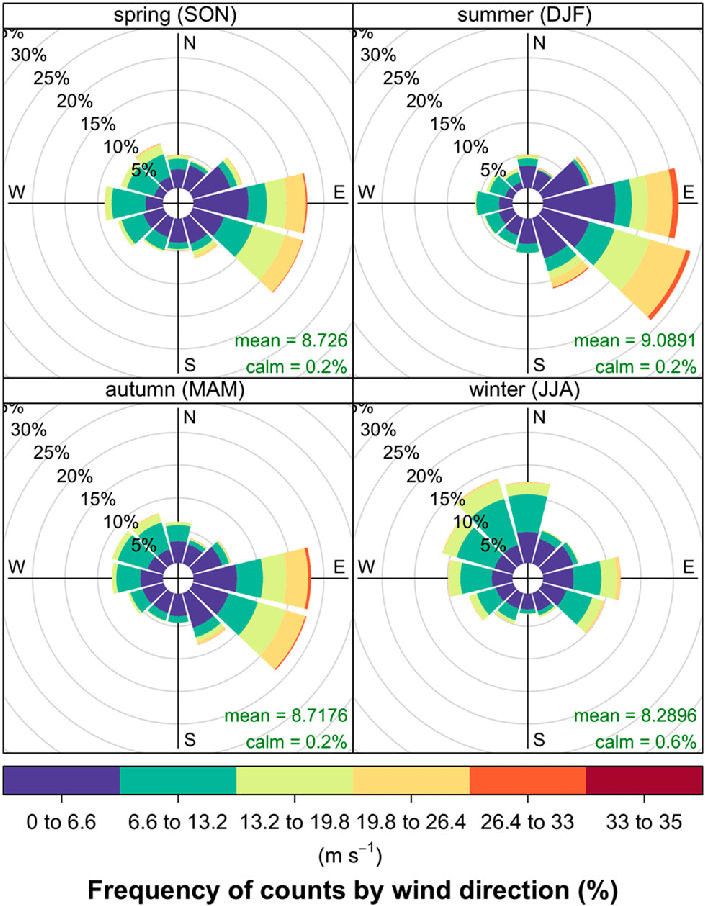
As you certainly know, Cape Town and the Western Cape have a rainy season from April to October, in winter, along with the wind, come storms and rain. In the summer months, it is rather dry and warm, so the wind can be quite pleasant. Keep this information in mind when reading the next chapters.
If you take a rough look at Cape Town from above, you’ll see the City Bowl surrounded by green mountains. This is why the districts of the Atlantic Seaboard are on the west side. I’ll describe the districts in the black box further down in the text.
The Districts of Cape Town
You’ve probably already looked at Cape Town on a map and were a bit overwhelmed. The city is huge and has many districts; how do you choose and find accommodation here? Cape Town is not a typical big city, even though it might seem large at first glance; fewer people live in the city center than in Cologne.
Most of the outlying districts are uninteresting or inconveniently located for you as a visitor. For a short visit, I recommend focusing more on the city center and the districts surrounding the mountains, such as Table Mountain, Lionshead, Signal Hill, and Devils Peak.
Let’s start simply with the city panorama. The mountains just mentioned enclose the city center. The highest mountain is Table Mountain, at approximately 1089 m, followed by Devils Peak at 999 m, Lions Head at 669 m, and Signal Hill, which you can also reach by car. This would give us districts located within the four mountains (City Bowl) and outside, on the edge of the mountains (Lions Head and Signal Hill) by the sea. These can be summarized as the “Atlantic Seaboard.”

Atlantic Seaboard
These two regions contain the districts you should focus on during your first visit to Cape Town (exceptions prove the rule). Of course, other places are also interesting, such as the Constantia wine region, the beach towns of Noordhoek and Hout Bay, or the kitesurfing beaches of Blouberg.
Due to rush hour traffic, however, these are difficult to combine with a city trip or short stay. Let’s start with the districts outside of City Bowl and Atlantic Seaboard. It’s certainly a good place to live long-term, but I only recommend it to a limited extent for a city trip.
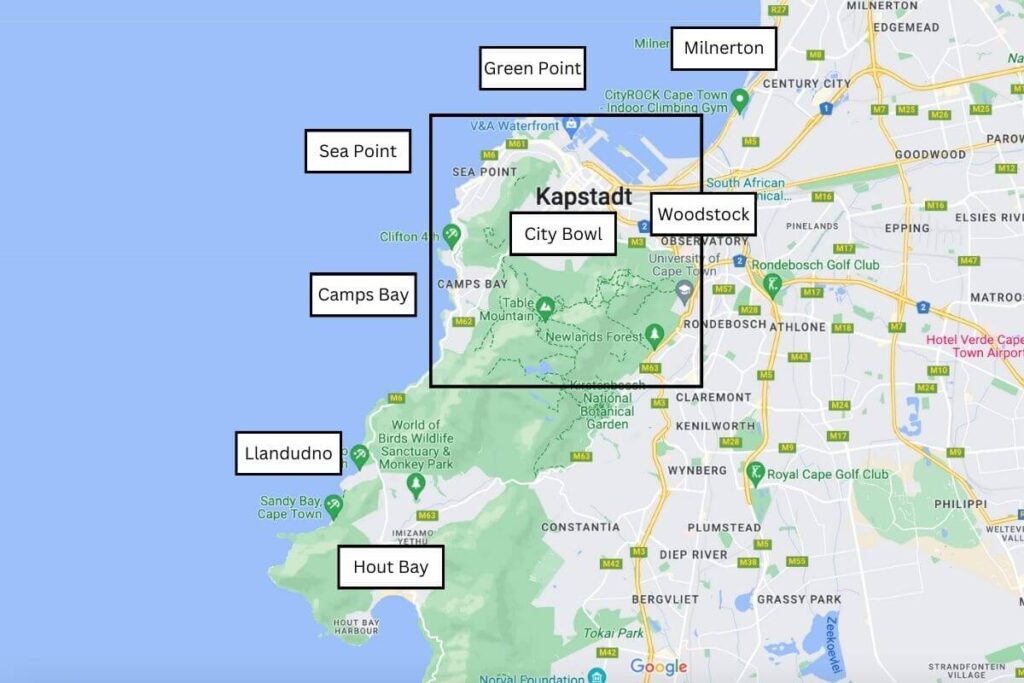
1. Northern Suburbs – Blouberg & Milnerton
The Northern Suburbs of Blouberg and Milnerton belong to the Afrikaans-speaking region. These Cape Town districts seem very affordable, but are unfortunately relatively far away. You would always have to drive into the city, and there are a lot of traffic jams on these routes (during rush hour). From Blouberg to the Waterfront in the city, for example, it’s about 19 km, and without traffic, it takes a good 30 minutes by car.
Alternatively, you can also take the MyCity bus, although it’s not always reliable or punctual. The towns in the Northern Suburbs are worth a day trip, for kitesurfing or to watch the sunset. If you’re staying in the city for a longer period, it might be worth staying here. In winter, it gets very windy and stormy here, as the wind blows directly from the sea onto the mainland.
- SOUL Atlantic Palms*
- Bliss Boutique Hotel*
- 5 Options Guest House*
- Kite Surfers Beach Villa*
- Blaauwberg Beach Hotel*
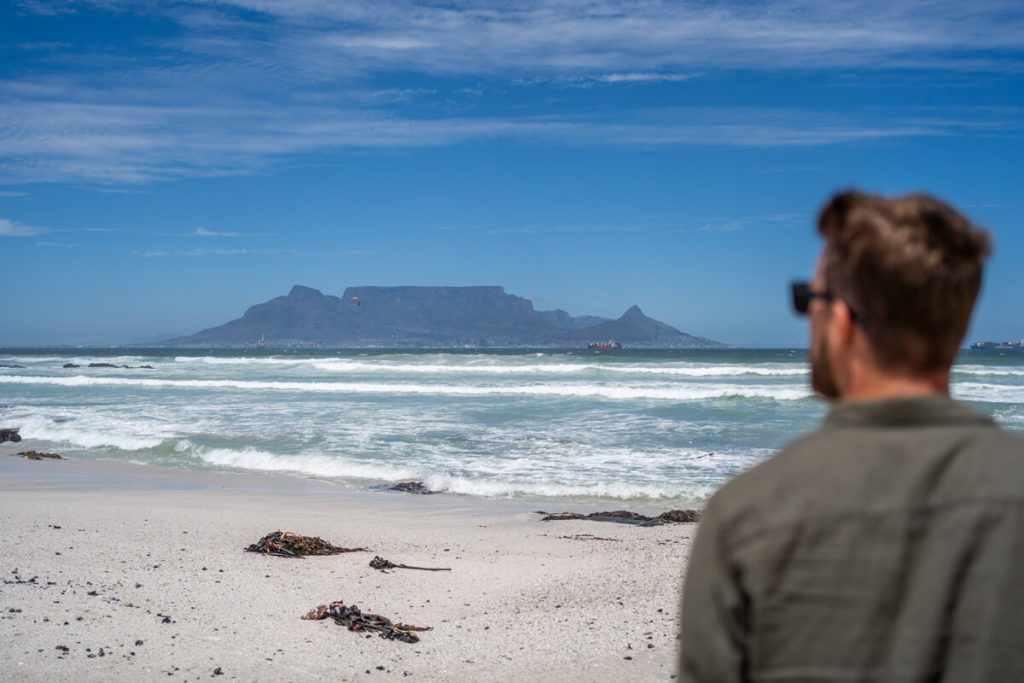
2. Woodstock & Observatory
Woodstock and Observatory are the “new” districts of Cape Town near the city center. There are many students, second-hand shops, and designers here. You’ll also find many small, hip cafés and restaurants. Unfortunately, the district isn’t entirely safe in my opinion, so I don’t necessarily recommend walking much here; it’s better to drive.
The city center is not within walking distance, so you almost always need your own rental car* or an Uber to get anywhere. Accommodation prices are a bit cheaper here. Woodstock is also home to the cool Neighbourgoods Market on weekends.
- DoubleTree by Hilton Cape Town Upper Eastside*
- Star Apartments*
- Madison Views of Table Bay*
- 108 Waverley*

3. Southern Suburbs
The Southern Suburbs are home to more English-speaking people. The Southern Suburbs are the districts that Capetonians consider “beyond the mountain.” These areas begin at the University of Cape Town (UCT) in Rondebosch and extend through the Constantia wine region to Muizenberg. Living here is quieter and certainly cheaper. However, the sun sets behind the mountains, so it can get darker on this side by 2 or 3 p.m.
Newlands (right on the mountain, including the Newlands Forest) is the rainiest place in all of South Africa due to its proximity to the mountain. You can then get into the city via the M3 and M5. I don’t necessarily recommend staying here on a short city trip, as getting into the city is very difficult. There are only a few roads here, although they can be very busy during rush hour.
☞ My winery recommendation in Constantia: Constantia Glen (Constantia half-day tour*)
- Neighbourgood Newlands*
- Vineyard Hotel*
- The Andros Boutique Hotel*
- Manor Boutique Hotel*
- The Victorian Goose*
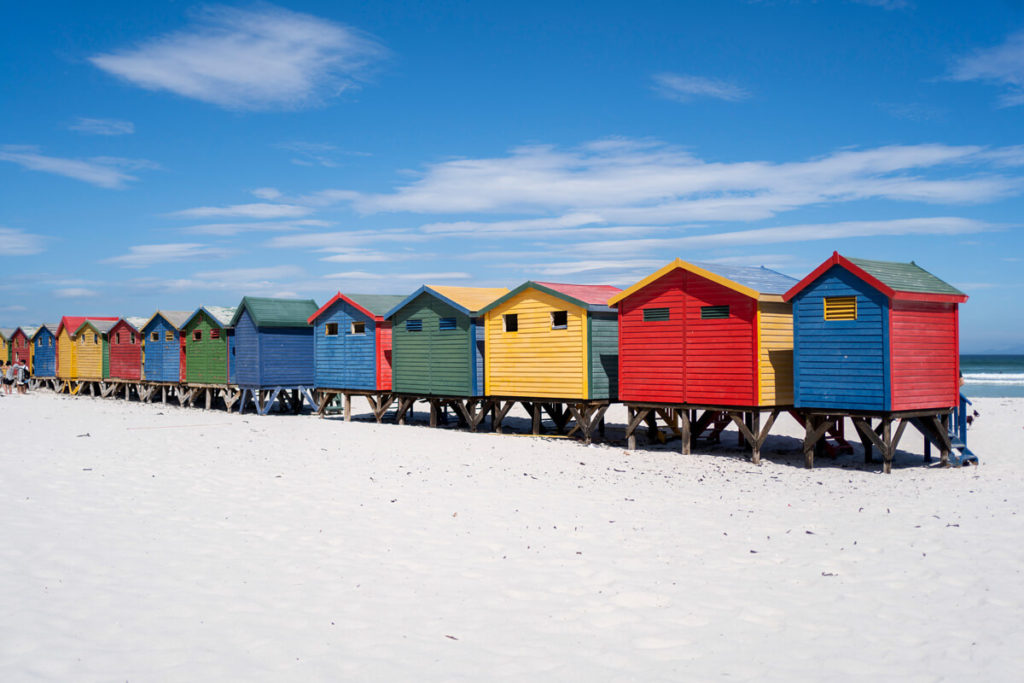
4. LLandudno & Hout Bay
The districts of Llandudno and Hout Bay actually belong to the Atlantic Seaboard, but are located a little further out. Llandudno is a beach with a large cluster of holiday homes. The beach is gorgeous and the accommodations luxurious, but there’s only one road in and out, and no shops like supermarkets or restaurants.
So you have a great house by the sea, but for shopping or dining, you’ll have to drive to Hout Bay or Camps Bay. If you’ve already been to Cape Town and aren’t really interested in sightseeing anymore, Hout Bay could be a great place for you.
The red Hop-On Hop-Off Bus* also runs along here, so you can use it as a means of transport. Hout Bay is a small fishing village with a beach and harbor right in the mountains. There are restaurants and all the small shops and supermarkets you could need.
The town is right next to Constantia and Chapman’s Peak, offering many excursion options. The drive into the city center can take around 30 minutes, perhaps a little longer in traffic. Many Germans live in Hout Bay, and it’s cheaper than in the city.
☞ My restaurant recommendation in Hout Bay: Dunes Beach Restaurant & Bar.
- Hout & About Guest House*
- Poseidon Guest House*
- The Marvel Beach House*
- Beach Music*
- Hout Bay Manor*
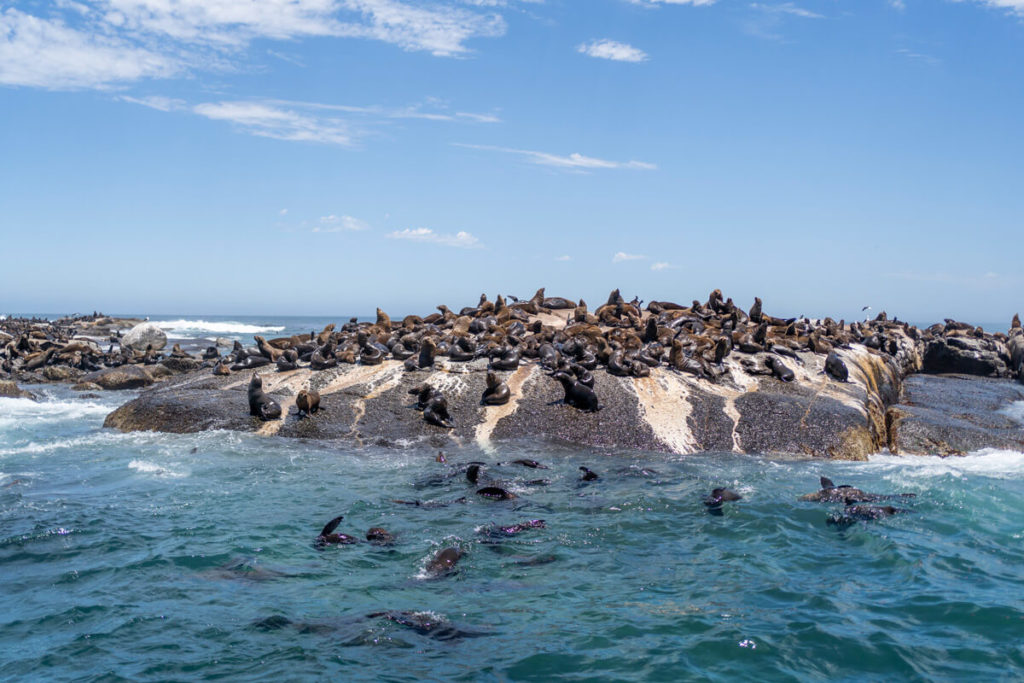
5. Central Business District
Let’s start in the center, in the heart of the city, in the Central Business District, or “CBD” for short. The name is already very clear: this is where the city’s business center is located, including Long Street and the Parliament. Living here is certainly convenient, as distances are short.
I also lived here for 2.5 years (before the pandemic). Due to the many business people and tourists, there are naturally also many beggars and homeless people trying their luck here. It’s noisier, but that means you never have to walk far for a coffee or a snack. From here, most of the Cape Town attractions are within walking distance. The popular “free walking tours” also take place here.
Since there’s so much going on here, it’s okay to walk short distances in the evenings. But please always listen to your gut feeling. Please also keep an eye on your valuables and bags. Long Street can be a bit tricky. You may be approached here often, especially by underage beggars. The only thing that helps here is to ignore it, no amount of change in the world will help these people, as 90% of it is invested in their parents’ drugs (more about safety here).
- Grand Daddy Boutique Hotel*
- The Onyx Apartment Hotel*
- Gorgeous George by Design Hotels*
- NOAH House*
- Urban Oasis Aparthotel*
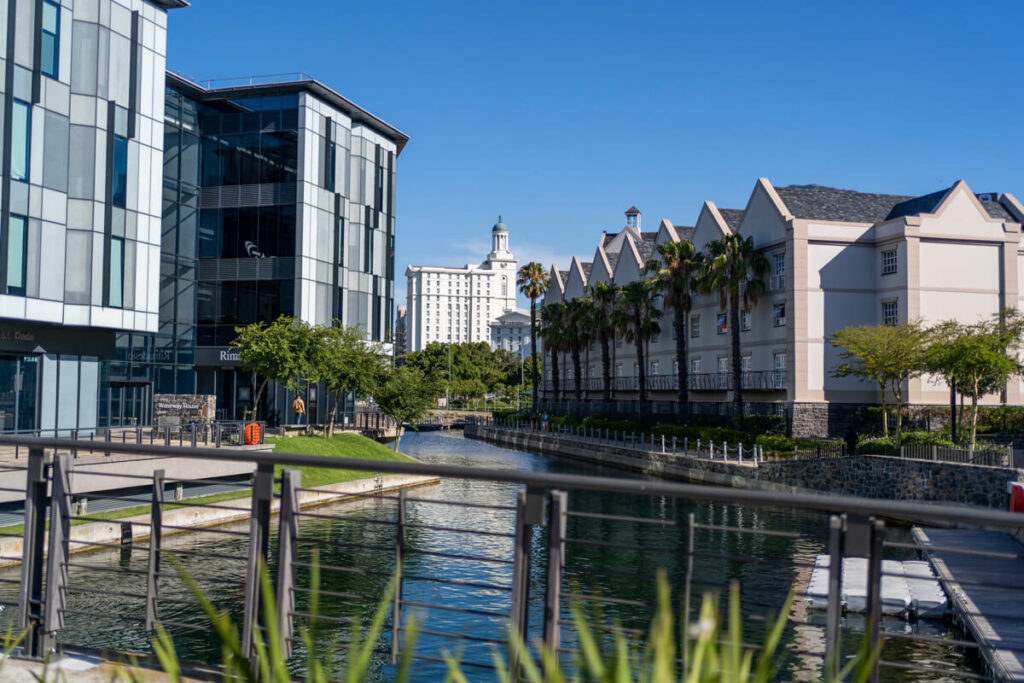
6. Bo-Kaap, Zonnebloem & District Six
Bo Kaap, the district with the colorful houses, is located right next to the CBD and in front of Signal Hill. The district runs uphill. I wouldn’t necessarily recommend staying here, as it’s quite steep, there are often few parking spaces, and it can get dodgy in the evenings. The same unfortunately applies to Zonnebloem.
The former District Six (which was completely flattened during apartheid; more information can be found at the District Six Museum) borders the CBD on the other side, as well as Woodstock. Here, you’ll find Harrington Street with many new restaurants, such as NY Bagels or Harrington’s Cocktail Bar.
If you want to stay here, I recommend choosing accommodation with parking. This district wouldn’t be my first choice as a visitor, but the lower prices can make it worthwhile. Please don’t walk around here alone in the evenings either!
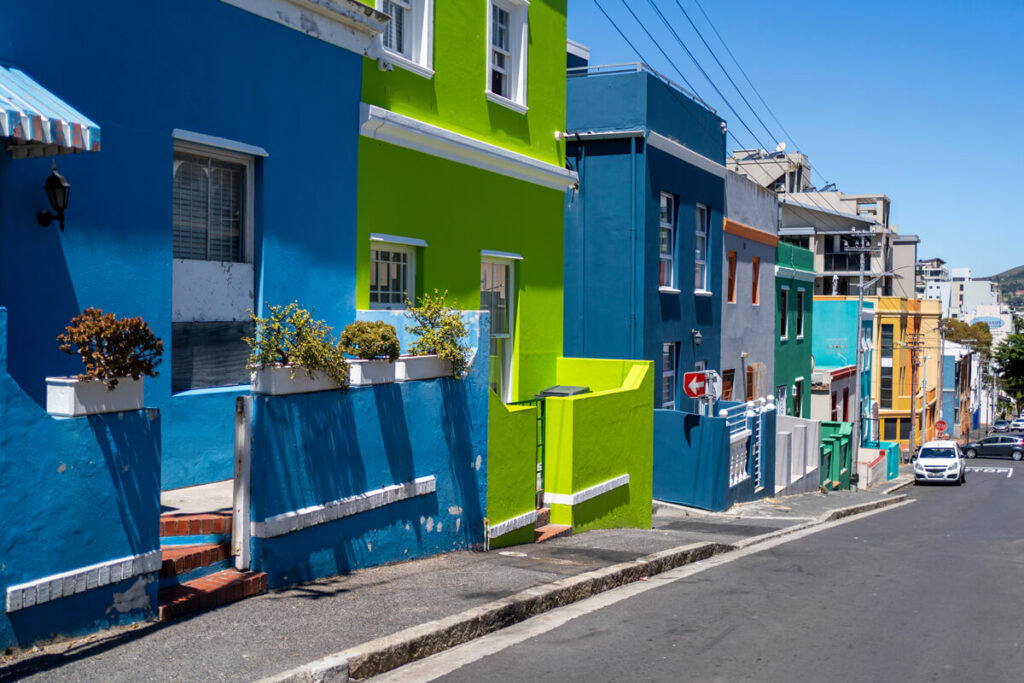
7. Gardens
The Gardens district borders the CBD to the south (towards the mountain). Here you’ll find the famous Kloof Street, the somewhat more glamorous extension of Long Street. There are great restaurants and bars, some of which are a bit more upscale. Company Garden, which leads to the CBD, is also located here. This region is generally quite affordable to live in and has excellent transport links. There are supermarkets here and even a small mall, the Gardens Center.
- Ashanti Lodge Gardens (Backpackers)*
- Never@Home Kloof Street Backpackers*
- Cloud 9 Boutique Hotel*
- Kloof Street Hotel*
- Mount Nelson Hotel*
- Tintagel Guesthouse*

8. Vrekehoek, Oranjezicht & Tamboerskloof
In the very south and almost on Table Mountain, the neighborhoods of Vrekehoek, Oranjezicht, and Tamboerskloof are located directly on the mountain. If you look at the mountain, you’ll see Vredehoek (where I live) on the far left, Oranjezicht in the middle, and Tamboerskloof on the far right at Lions Head. If you’re looking for a quieter place to stay and close to the mountain for hiking activities, these neighborhoods are the right place for you.
Most guesthouses are family-run and a bit smaller than the large hotels further down in the city. These neighborhoods are comparable to German suburbs, as there are still many single-family homes and each has a small “center” where you’ll find the supermarket and one or two cafés and bars. From here it is a 45-60 minute walk to Tafelberg Road, from where the cable car to Table Mountain departs (tickets for the cable car are available here*).
- De Tafelberg Guesthouse*
- Three Boutique Hotel*
- Rosedene Guest House*
- Cape Paradise*
- Cape Riviera*
- Abby Manor

9. Foreshore & De Waterkant
Foreshore and De Waterkant are the districts in the far north of the City Bowl (towards the sea). They form the region in front of the harbor and the waterfront. The Foreshore, which is more of a business district, consists of many tall buildings. The trade fair (convention halls) is also located here, so hotels and restaurants are less family-oriented.
There are currently many construction sites here, as many are being redeveloped. Did you know: Back when Cape Town was discovered and built, the Castle of Good Hope was the waterfront. More and more land was reclaimed, so that the entire Foreshore district now lies between the Castle and the sea.
De Waterkant forms the area between Bo Kaap and the waterfront and borders Greenpoint. This region is ideal for living if you’re short on time and need short distances. You can quickly reach both the CBD and the waterfront. The sea and therefore the promenade are also not far away.
Great accommodations in Foreshore & De Waterkant
- Silo Hotel*
- One&Only Cape Town*
- Cape Grace*
- Hotel Lola*
- Radisson Blu Hotel Waterfront*
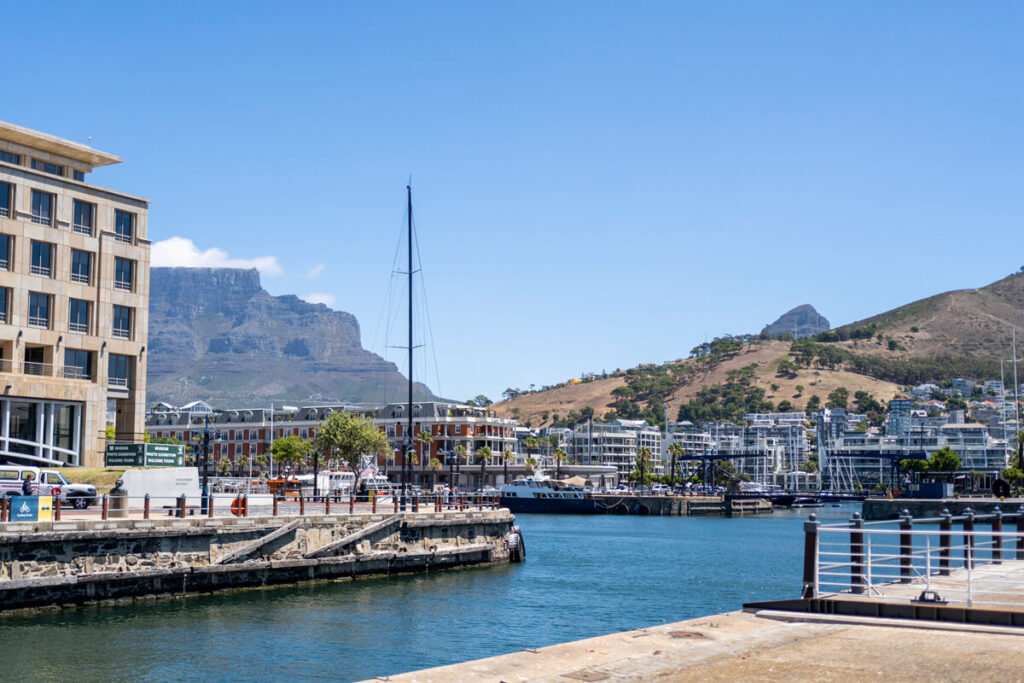
10. Green Point & Mouille Point
Along with Sea Point, this is probably the most popular district in Cape Town. The region borders the waterfront and the Atlantic Ocean, so you can do a lot on foot. By the Atlantic Ocean is the promenade, which is particularly popular with athletes, but is also perfect for a long stroll along the water.
The Greenpoint district then leads up Signal Hill, which is why the streets here can be very steep. So make sure your accommodation here has its own parking space (or at least book an automatic rental car*).
There are many restaurants and supermarkets along the main street, so you’ll always have short distances to go. Accommodation here is usually a bit more expensive than in the City Bowl, but usually offers great views, including of the sea. In winter, however, the wind can make it very cold and wet.
Great accommodation in Green Point & Mouille Point
- THE BIG – Luxury Backpackers*
- Curiocity Backpackers*
- Never@Home Greenpoint Backpackers*
- The Winchester Boutique Hotel*
- Cape Standard Guest House*
- Dolphin Inn* (Mouille Point)
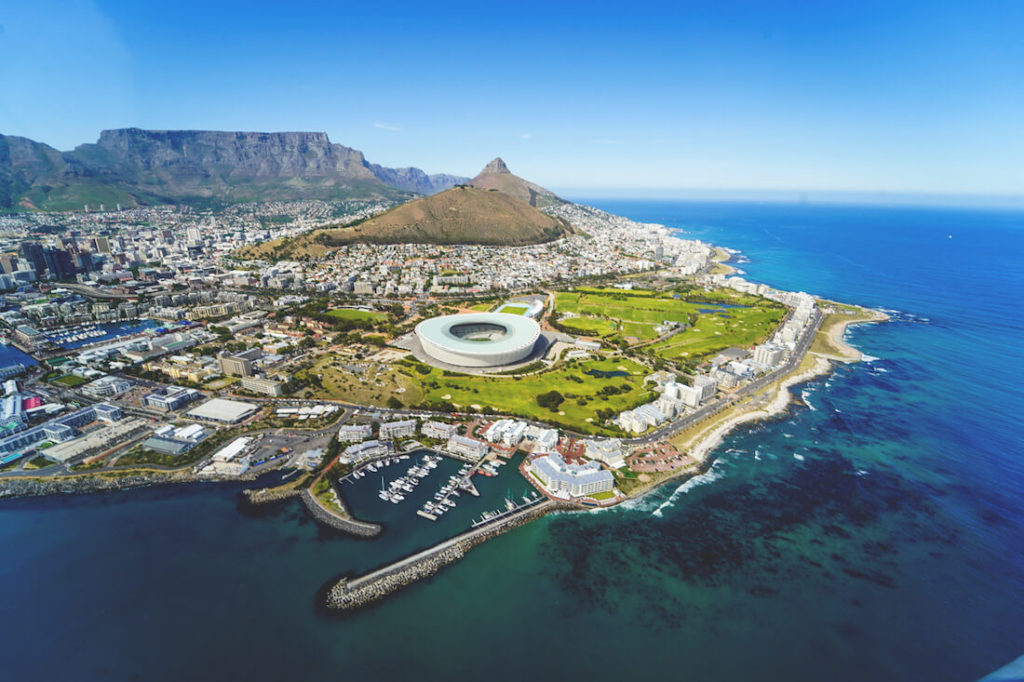
11. Sea Point & Fresnaye
Sea Point is probably the most popular district of Cape Town among visitors: right on the sea with countless restaurants. This district is located directly on Lionshead and borders the more expensive suburbs of Clifton and Camps Bay. Sea Point has several small beaches, although the sand is not as fine as that of Clifton Beach or Camps Bay Beach. The promenade continues here from Greenpoint.
There is an outdoor pool right by the sea and many events on the promenade or on Beach Road. Along the main street, there are also many restaurants, supermarkets, and a market hall, the Mojo Market, with live music and many food stalls. There’s always something going on here, but in a more civilized way than is sometimes the case in the CBD.
- The Clarendon*
- Home Suite Hotels Sea Point*
- Compass House Boutique Hotel*
- Latitude Aparthotel*
- Sundown Manor*
- The President Hotel*
12. Bantry Bay & Clifton
From here and further along the sea to Camps Bay, the houses get bigger and the rents more expensive. But you get sea views everywhere. In Clifton, there are four beaches, creatively called Clifton 1-4. You can swim in these small bays if you dare to venture into the cold water, or watch the sunset from the sand/rocks. Accommodation here is more expensive, and there are no restaurants or supermarkets; for those, you’ll have to go to Camps Bay or Sea Point. Having your own car is an advantage.
- The Clarendon – Bantry Bay*
- Ellerman House*
- Glass House Getaway*
- Cassandra
- 21 Nettleton Boutique Hotel & Luxury Residence*
- Wixy (Beachfront Villa)*

13. Camps Bay
Camps Bay is the district of the rich and beautiful. Camps Bay is located directly on the seafront, with a small promenade full of restaurants and bars. The houses are more like small villas, and this is reflected in the prices. If you prefer to spend some time on the beach in peace and quiet, stay in this part of town. Hiking trails lead directly up the mountain (Pipe Track), and by the sea, you’ll find many joggers and cyclists, or people can sit in one of the small beach cafés after a workout.
During the summer weeks and especially during school holidays, the beach can get very crowded. It’s worth walking here or parking your car further away. It’s especially beautiful in the evening, as the sun gradually disappears over the horizon. There are numerous bars along the beach promenade. Please note: Parking on the side of the road is free here, although the “parking attendants” may charge you up to €15. Just ignore them! A small tip is, of course, appreciated.
Great accommodations in Camps Bay:
- Ocean View House*
- The Marly*
- House of Karuna*
- African Vibes Camps Bay*
- Royal Boutique Hotel*
- Azamare Guest House*
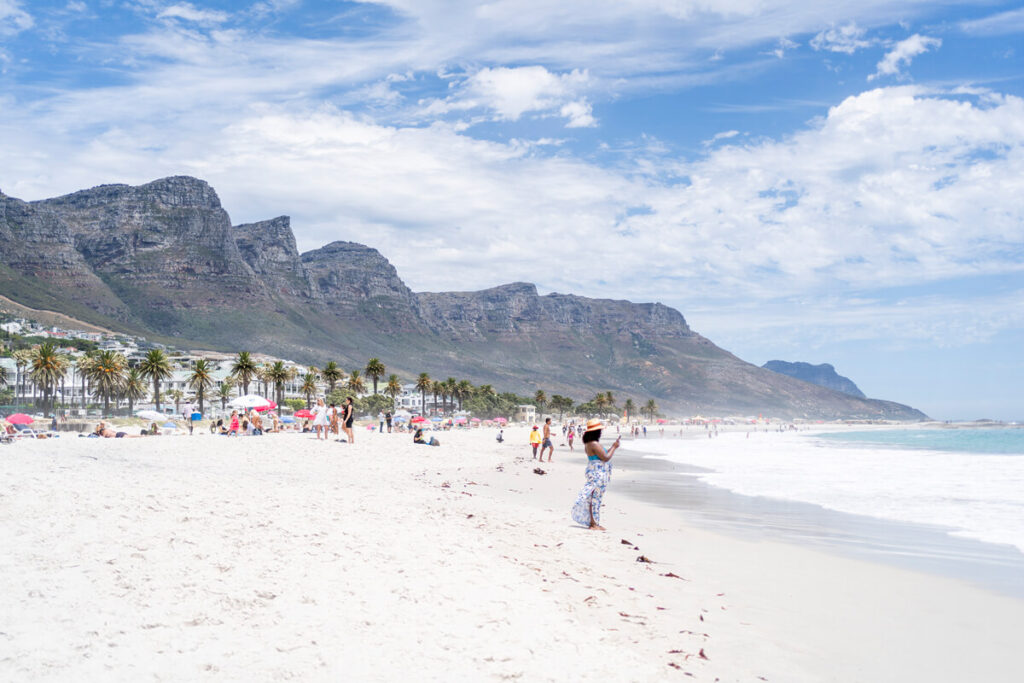
Districts in Cape Town – My Conclusion
The most popular districts in Cape Town among visitors are City Bowl, Green Point, Sea Point, and the Waterfront. Here you can enjoy not only the central location but also a great tourist infrastructure. If you’re less concerned about your budget, great accommodations in Clifton and Camps Bay might also be of interest to you.
I hope I was able to give you a better overview of the individual neighborhoods of Cape Town. Depending on your budget, time, and preferences, you can now decide at your leisure which neighborhood you like best. If you’re still overwhelmed with travel planning, feel free to contact me for further tips or send me a message if you’d like me to take care of your entire travel planning: www.sinclairsafrica.de/uber-cristine-wekenborg